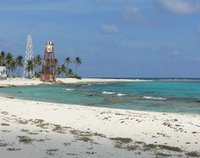Half Moon Caye

Recently, I had the opportunity to visit Half Moon Caye National Monument, which in 1928 became Belize's first protected area. I was on a boat with a few of the BAS staff members for about two hours before we reached Half Moon Caye of Lighthouse Reef. This was my first escape from the mainland. I saw a flyingfish gliding out of the beautiful waters of the Caribbean.  Half Moon Caye is managed by Belize Audubon Society, along with the nearby Great Blue Hole. The shores are lined with coral rubble and white sand. On the eastern end of the island is an old lighthouse and coconut palms. The western end is a much more diverse in vegetation.
Half Moon Caye is managed by Belize Audubon Society, along with the nearby Great Blue Hole. The shores are lined with coral rubble and white sand. On the eastern end of the island is an old lighthouse and coconut palms. The western end is a much more diverse in vegetation. The Red-footed Booby (Sula sula) colony is one of the main reasons the natural monument was created. Half Moon's colony is unusual in the Caribbean context because of the almost complete dominance (98%) of the white, gold, and black adult color phase. An observation deck was built for visitors to view the colony in the canopy. The Magnificent Frigatebird (Fregata magnificens), which nest in the same Orange-flowered Ziricote thicket at the western end of the caye are also common.
The Red-footed Booby (Sula sula) colony is one of the main reasons the natural monument was created. Half Moon's colony is unusual in the Caribbean context because of the almost complete dominance (98%) of the white, gold, and black adult color phase. An observation deck was built for visitors to view the colony in the canopy. The Magnificent Frigatebird (Fregata magnificens), which nest in the same Orange-flowered Ziricote thicket at the western end of the caye are also common.
Boobies and Frigatebids have an intersting realtionship on the island. Boobies frequently destroy the Frigatebird nests, while Frigatebirds feed on Booby eggs. The Red-footed Booby feeds by diving into the water for fish, while the Frigatebird, a poor diver, steals fish from the Booby. This behavior is depicted in the logo of the Belize Audubon Society.
Half Moon Caye a great place to bird watch because you don’t know what to expect. Nearly 100 species have been recorded here, 77 of these are migrants. I saw an osprey perched on a coconut palm and what I suspect was a yellow warbler. The purpose of my visit to Half Moon was to introduce myself to the staff members and to look at how the small visitor center could be enhanced with exhibit signs. I can’t wait to return with some free time so I can explore more of the beautiful island diversity and the reef.
The purpose of my visit to Half Moon was to introduce myself to the staff members and to look at how the small visitor center could be enhanced with exhibit signs. I can’t wait to return with some free time so I can explore more of the beautiful island diversity and the reef.



No comments:
Post a Comment